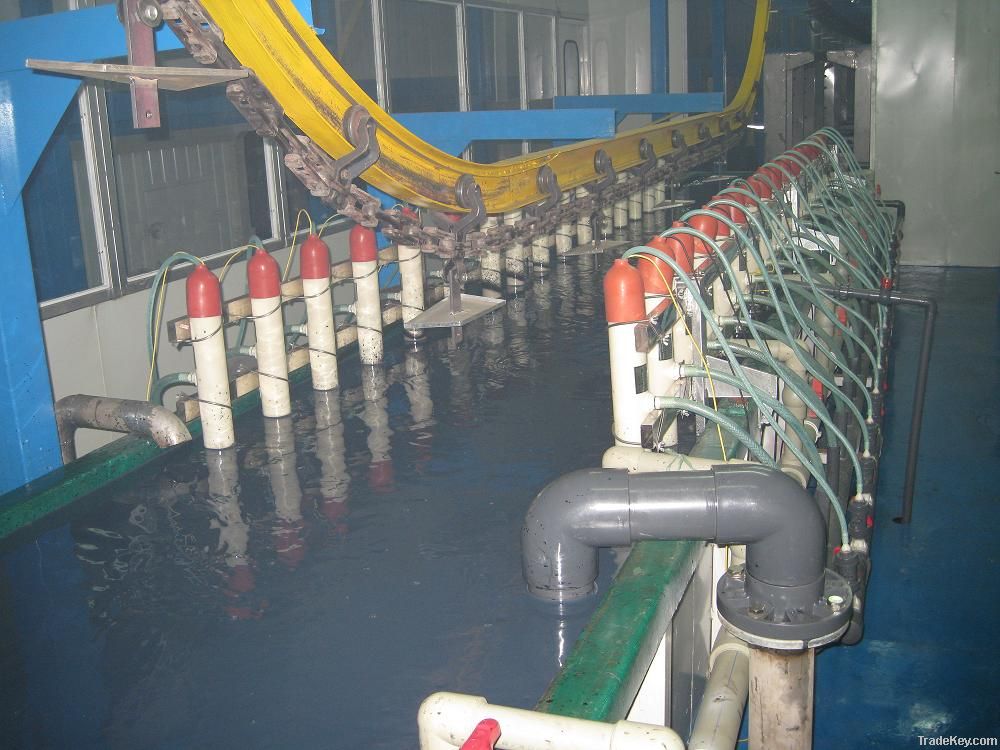الوصف
The Basics of
Electrocoating:Electrocoating is a process
critical to every segment of metalworking industries. Advanced
electrocoating systems allow product designers greater latitude
in the choice of materials, improve the performance and wear
properties of critical components, and give metals a high
quality, nonporous, high-adhering surface for the subsequent
application of liquid or powder topcoats, where desirable.
Definition:
Electrocoating
uses electrical energy to apply organic finishes. The part is
grounded and immersed in paint that has been charged with the
opposite polarity. Resin and pigment migrate to the part, and a
uniform film is irreversibly deposited. The part is rinsed, then
cured.
Critical
Processes: Successful film deposition
depends on four simultaneous processes:
· Electrophoresis
- the movement of colloidal materials dispersed in liquid under
the influence of a potential gradient.
· Electrolysis
- the dissociation and movement of ions.
· Electro-osmosis
- (the reverse of electrophoresis) the extraction of water from
the deposited film.
· Polarization
- the ability of the deposited film to exhibit electricity
resistance, thereby insuring even coverage.
E-Coat
Advantages: Properly engineered systems
offer precise control over film thickness, highest film integrity
and an unblemished appearance. The process offers extremely high
repeatability of results, and is a practical alternative for
metal parts of virtually all sizes and shapes, gauges and
grades.
The most common applications of
electrocoating include underhood/underbody components,
recreational goods, cooking and laundry appliances, HVAC
products, and aerospace products. Recently, manufacturers of
upscale consumer products have popularized electrocoating as a
primer for powder-coated goods.
E-Coat and the
Environment: Electrocoating benefits the
user in several important ways. Closed loop rinsing,
ultrafiltration, and the applications process itself allow
material utilization of virtually **0%. Many electrocoat paint
formulas are now available which are free of heavy metals; many
are also near-zero in VOCs and HAPs.
Electrocoating may not require a
dry-off oven, thus exhaust air and makeup needs are minimized.
Finally, because the paint is ****0% water, the risk of fire -
the ultimate environmental disaster - is vastly reduced.
The
Anodic/Cathodic Debate: Anodic systems deposit a
negatively charged polymer onto a positively charged part; in a
cathodic system, the reverse is true. We can demonstrate, and
help you compare these options in terms relevant to your plant,
your product, your production, and your future requirements.
Today, acrylic, epoxy and hybrid electrocoating are the
alternatives. Of these, cathodic epoxy deposition systems are
widely regarded as the ultimate in terms of delivering high
hardness, excellent salt spray and other performance
properties.
We have extensive experience with
all these systems, and can help you consider what level of
performance you need. Would a system that delivered slightly less
performance, at significantly less cost, better serve your needs?
Exploring all options, objectively, and in detail, is, we
believe, the most important due diligence you can perform in
making an e-coating decision.
| بلد: |
China |
| نموذج رقم: |
JDL
|
| سعر فوب: |
(قابل للتفاوض)
أحصل على آخر سعر
|
| الموقع: |
- |
| سعر الحد الأدنى للطلب: |
- |
| الحد الأدني للطلب: |
- |
| تفاصيل التغليف: |
- |
| موعد التسليم: |
- |
| القدرة على التوريد: |
- |
| نوع الدفع: |
L/C, T/T |
| مجموعة المنتج : |
- |


